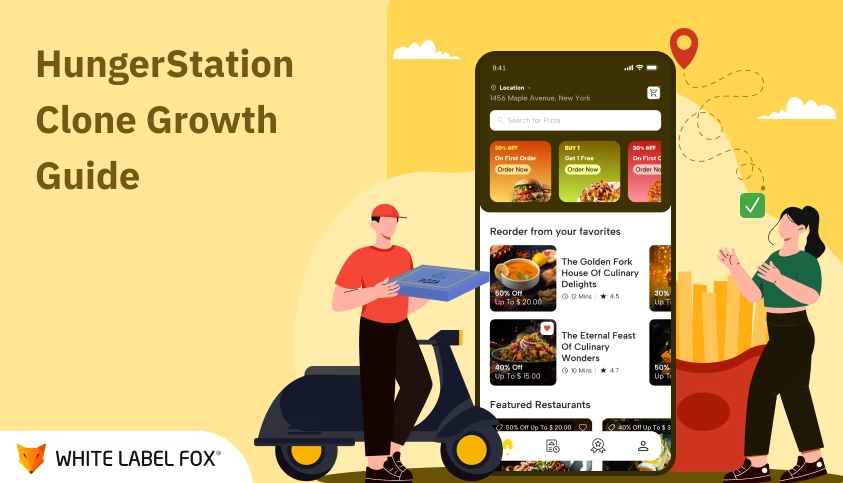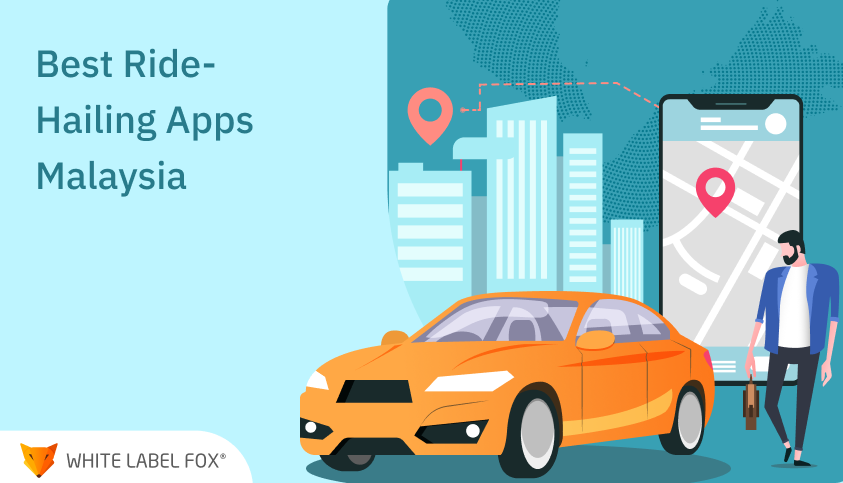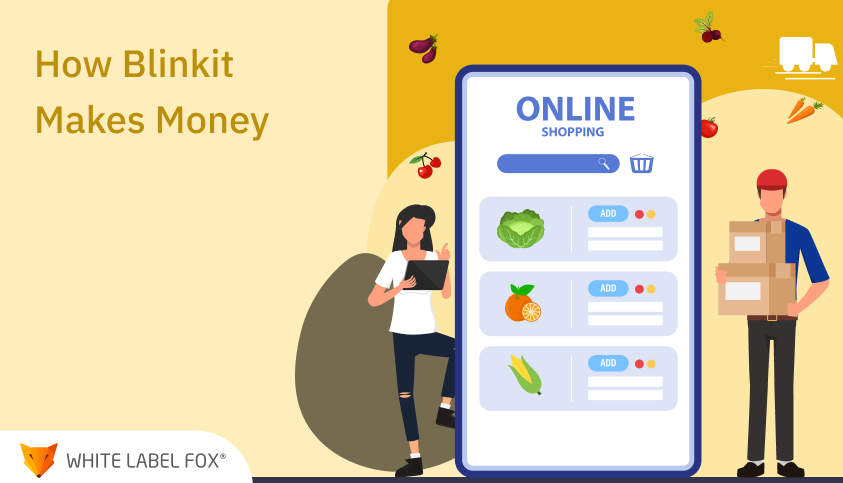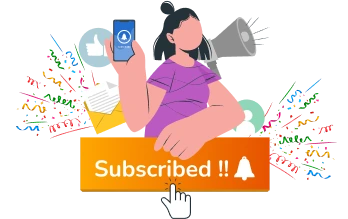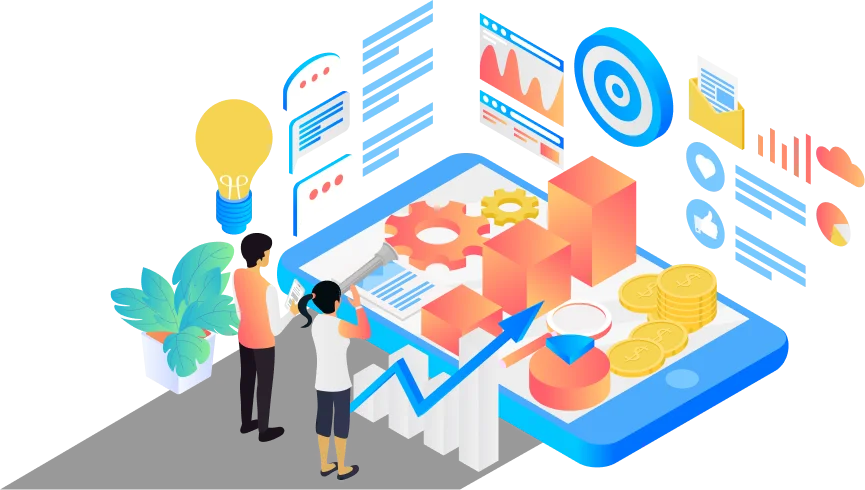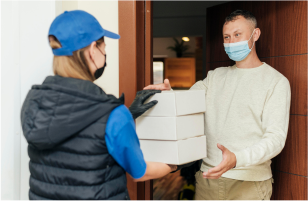The food delivery app startup is no longer the new norm. Today, numerous on-demand delivery apps operate globally. Saudi Arabia is not exceptional, as online food and grocery delivery apps like HungerStation have become household names. For those seeking to transform the market, investing in a HungerStation clone app offers a revenue-generating opportunity.
However, the success of your on-demand food delivery cloned apps depends more on understanding the business model and growth strategies rather than their functionalities. If you're looking to step into the $10.04 billion online food delivery industry in Saudi Arabia, this blog is for you. Check on what HungerStation clone is, the business model of a food and grocery delivery platform, and more to make smarter decisions.
What is HungerStation?
When it comes to the well-known Saudi Arabia-based delivery platforms, we can't miss the name HungerStation. Came into operation in 2012, the delivery platform now operates in 102+ cities. Acquired by Delivery Hero for $297 million in 2023, HungerStation is experiencing a 36% revenue growth every year.
With 55,000+ partners the company has become the top option for customers in Saudi Arabia & Bahrain. HungerStation is focusing on increasing the delivery experience. With 2X faster deliveries, the delivery platform continues to grow in the Saudi market.
What is the HungerStation Clone App?
It's a food delivery app for startups and giants looking to invest in a solution that replicates the functionalities of the HungerStation. It enables startups to launch their food delivery business quickly without developing an app. This HungerStation clone comes with different modules, including the following:
- Admin Panel
- Customer App
- Restaurant App or Website
- Delivery Partner App
Although it's a ready-to-use delivery solution, you can get it customized to ensure it meets all your business requirements. It's a cost-effective food delivery solution that helps entrepreneurs enter the competitive delivery industry.
Launch Your HungerStation Clone in Just a Few Days
Get a fully customizable, ready-to-deploy food delivery solution built for the Saudi market. Scale faster with enterprise-grade features.
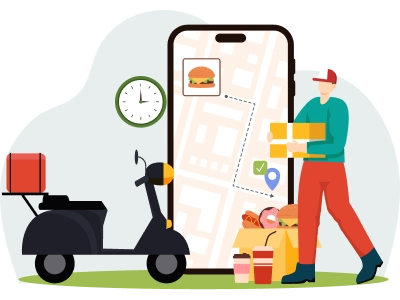
Understanding HungerStation’s Business Model
Having deep insight into HungerStation’s business model helps you know what drives its success in the $1.40 trillion delivery market. Let's explore how HungerStation works to offer a satisfying customer experience.
HungerStation’s Three-Sided Marketplace Model
Saudi food delivery platform operates on a three-sided marketplace model. An interconnected ecosystem of HungerStation bridges the gap between:
Restaurants/Stores: Brands that register on the platform to reach more customers.
Customers: One who can use the website or download the app from Google Play Store or Apple App Store to order and track their daily essentials.
Delivery Partners: Independent contractors who deliver orders to customers to earn extra money.
HungerStation's multi-stakeholder model helped the company operate smoothly. Additionally, the AI-based personalized recommendations help the delivery platform keep customers happy.
HungerStation Revenue Model: How the Saudi Delivery Platform Makes Money?
The estimated annual revenue of Saudi Arabia's food & grocery delivery platform is $709.3 million per year. The diversified HungerStation revenue model ensures consistent income across its ecosystem. Let's discuss how HungerStation makes money and how you can do the same with a food delivery app startup.
Commission & Delivery Fees
The primary source of revenue for HungerStation is the commission charged for delivery from restaurants and other partners. The delivery platform charges around 15 to 30% from the restaurant. Moreover, it also collects delivery fees from customers; the commission & delivery fees are based on various circumstances, like:
- Restaurant Type
- Distance Need to Be Traveled
- Partnership Level
- Order Value
- Restaurant Location
Customers with subscription programs have to pay lower delivery rates. HungerStation also runs free delivery promotions to attract new users, but balances them with different revenue strategies during peak hours.
Paid Advertising
Restaurants can get their business listed on top within the app with paid promotions. They can advertise to enjoy various benefits like:
- Spot on homepage
- Rank high on the search engine
- In-app banners or sponsored deals
Such visibility-based monetization is beneficial for restaurants and HungerStation.
Loyalty Programs
HungerStation subscription-based plans make users pay fixed monthly fees to enjoy various things, like:
- Free deliveries
- Early access to deals
- Reward points
- Cashback offers
- Loyalty programs
The HungerStation revenue model ensures financial sustainability through multiple channels. Utilizing an interconnected ecosystem for your HungerStation clone app enables you to grow and generate a steady profit.
Steps to Build Your HungerStation Clone App
Without knowledge, stepping into on-demand food delivery cloned apps development can end in business failure. To avoid all pitfalls, business owners must follow a proper guide to create a scalable food delivery platform like HungerStation. These include:
Identifying Market Niche
It's essential to understand your:
- Targeted audience
- Local market trends
- Competitors
Understand your customers' pain points to offer a better experience with your food delivery app startup. Also, decide whether you'll focus on:
- Meal or grocery delivery
- Specific cuisines or restaurants
- Urban or hyperlocal regions
Conducting market research can help you grab the spotlight for your HungerStation clone. It also helps you have a future road map, driving more success for your delivery business.
Define the Business & Revenue Model
Outline how your on-demand food delivery cloned apps will operate and help you make money. You can choose the HungerStation business model as well as the revenue strategy to ensure long-term scalability for your platform.
Choose Technology Stack
A strong tech foundation is essential for a scalable delivery application. Check the list of technologies you can use for developing an app like HungerStation:
| Component | Recommended Technology |
|---|---|
| Frontend (Mobile) | Flutter, React Native |
| Backend | Node.js or Laravel |
| Database | MongoDB |
| Payment Gateway | Stripe |
| Cloud Infrastructure | AWS, Google Cloud |
| Real-Time Tracking | Google Maps API |
| AI & Analytics | TensorFlow, Dialogflow, Scikit-learn |
Using the right mobile app development technology is essential for the success of any platform, and delivery is not exceptional. For a better understanding, please email us at [email protected]
Intuitive User Interface
It's your delivery app that users come across first. Hence, it becomes essential to create an engaging user interface that catches the eyes of platform visitors. Focus on clean design across all grocery delivery modules. Primary UI/UX considerations include:
- Simple navigation
- Quick checkout process
- Easy menu browsing
- Minimal clicks
- Responsive layout
Engaging UI helps you keep your customers coming back.
Don't Forget About Functionalities
Platform features play a vital role in its success. Hence, consider including all the essential features in your delivery app similar to our HungerStation. Check the list of models and features you need to include in your meal ordering solution.
Customer App:
- Register & login
- Search for items
- Real-time tracking
- Multiple payment options
- AI-based recommendations
- Ratings and reviews
Restaurant Panel and App:
- Signup and Signin
- Menu listing and management
- Order tracking
- Sales analytics
- Update order details
- Promotional tools
Delivery Partner App:
- Register
- Submit documentation
- Accept or reject the delivery request
- Earning report
- Route optimization
Admin Panel:
- Create & manage codes
- Review documentation
- Restaurant performance reports
- Check customers feedback
- Order history
- Earnings & payments
- Push notifications
AI and Automation Integration
More than 70% of companies are using artificial intelligence to automate their daily tasks. Whereas, 32% are testing it into their operations. Using AI and automation helps to streamline tasks, resulting in more business.

Source: (McKinsey)
HungerStation also uses AI-Powered 'Shaded Route' to help drivers save themselves from desert heat. You can also use this modern technology to stand out in the delivery market:
- Personalized recommendations
- Smart delivery assignment with ML algorithms
- Manage peak hours with dynamic pricing
- Instant customer support
Automation helps you improve operational efficiency.
Minimum Viable Product
Launching an MVP is a smart move for startups like you who've a limited budget. It helps you understand how your delivery platform performs in the real market. After trying with core features, you can launch the advanced version.
Launch & Promote
Once your delivery solution is ready, you need a successful promotion approach. Try different marketing strategies to build a strong presence in your targeted regions. You can try hand with different delivery platform marketing methods like:
- Social media promotions
- Influencer collaborations
- Referral bonuses
- Restaurant onboarding offers
Launching your food delivery app like HungerStation without the right strategy is not a smart move. This can result in your business's failure. An effective promotion strategy can help you build initial traction.
Monitor Performance
Launching your meal delivery platform is not enough. You also need to track the overall performance of your meal & grocery delivery solution. Use the analytics dashboard to track all data and use it to improve overall business operations. These analytics can also help you update your delivery app features, helping you keep it relevant to the market.
Grow with Your Business
Investing in a ready-to-use application = investing in a scalable solution. For example, with the core featured delivery application, you can start operating in your region and expand later after its success. You can scale your HungerStation-like solution once you gain a positive response with the basic model.
HungerStation Clone Development Cost Breakdown
Wondering about the HungerStation clone app development cost? Check the table below to get a rough idea of how much you must pay to start your meal and grocery delivery solution in Saudi Arabia:
| Development Stage | Estimated Cost |
|---|---|
| UI/UX Design | $1,888 – $5,888 |
| Frontend & Backend Development | $8,888 – $28,888 |
| API Integrations | $800 – $5,888 |
| Quality Assurance | $800 – $2,888 |
| Deployment & Launch | $888 – $18,888 |
Average cost of ready-to-use platform is around: $4,800 – $58,000
AI-powered versions with smart delivery automation cost between $48,888 – $88,888 or more.
Factors Affecting Development Cost for On-Demand Food Delivery Cloned Apps
There are lots of factors that affect the cost of a food delivery app startup. These include:
- Platform selection (Android/iOS or both)
- Functionalities complexity
- Custom integrations
- Tech stack used
- UI/UX design complications
There are lots of other things as well that affect the overall development cost. To save your time and money, you can move ahead with a ready-to-use food delivery solution like HungerStation.
Growth Tips for Food Delivery Startups
Smart partnerships and customer-centric strategies are required for food and grocery delivery business growth. However, there are many more circumstances to consider, these include:
- Focus on Hyperlocal Marketing
- Offer Discounts Strategically
- Use AI for Personalization
- Partner with Cloud Kitchens
- Optimize Logistics
- Invest in Customer Support
Every successful delivery startup like DoorDash or HungerStation thrives on a balance of strategies. By focusing on personalization and improving engagement, you can also position your food delivery platform on top.
Launch Your Food Delivery App Startup in Saudi Arabia Today!
White Label Fox knows how important it is to keep your customers satisfied. So we provide you with a HungerStation clone that helps you deliver high-quality services every time. Investing in a customizable platform like HungerStation gives you the chance to tap into Saudi Arabia's growing market with a proven business model that works.
With us, you get a solution that is built to perform and grow. On-demand food delivery cloned apps we create help you offer a reliable experience that saves time and makes your customers feel effortless. To discuss your requirements, please contact our team at [email protected]
Frequently Ask Questions
• Customers can search for nearby restaurants
• After browsing the menu, customers can order whatever they want
• The restaurant/shop prepares the order
• The delivery person collects the parcel
• The driver delivers the parcel to the customer
• Customer makes a payment and gives feedback
The whole process is managed through an intuitive dashboard that helps you track orders, payments, and manage all business operations from a single panel.
• Features
• Design complexity
• Technology used
• Development region
A fully functional HungerStation clone can cost between $4,8888 and $58,888. For exact pricing, contact: [email protected]
• Service Availability
• Store Settings
• Track Providers
• Wallet History
• Meal Customization
• Store Promotions
• Invoice Generation
• Payment Methods
• Choose Language
• Analytical Dashboard
• Grocery delivery
• Medicine delivery
• Parcel courier services
• Home essentials
Start with one service and expand into multiple on-demand services easily.
• Set service areas
• Manage multiple cities
• Restrict regions easily
All from one centralized dashboard.
• Region
• Languages
• Services
• City-level targeting
Region-specific marketing tools help you serve customers effectively.

